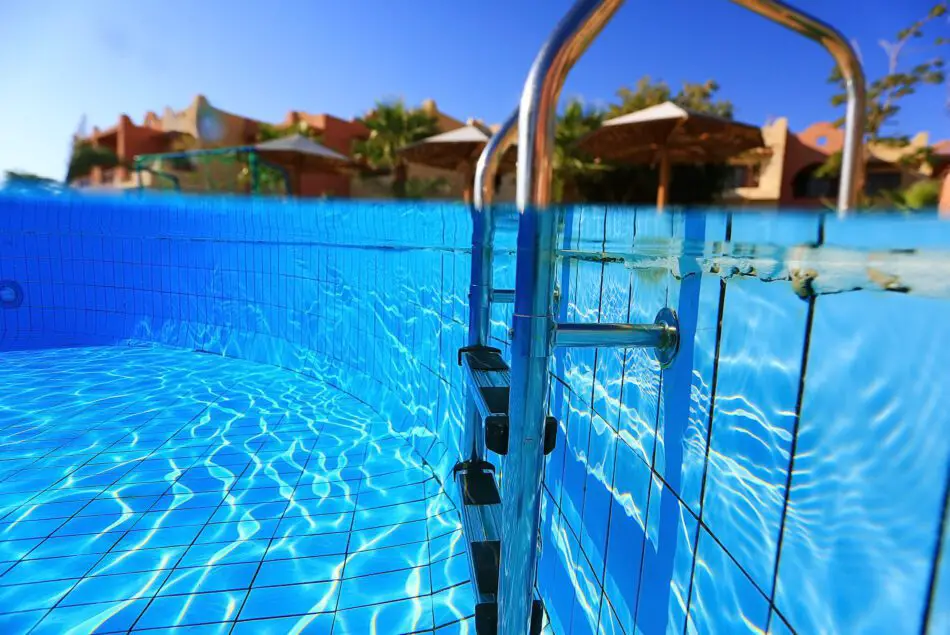
Borates provide many benefits to your swimming pool. Read on to learn more about why you should consider using borates!
Algae blooms are an inevitable part of pool ownership. Maybe you had a rainstorm or a big pool party that threw off your pool chemistry. Or maybe you have been slacking on your pool maintenance for a bit. Either way, your pool may not be a fun place to be right now. In addition to being unsightly, algae can come with a host of problems, including water bugs, irritants and infections, and damage to your pool’s surface.
In situations like these, you may assume algaecide is the best option to treat your pool water, but that is not always the case. In this article, we will review the facts about algaecide, when to add algaecide to pool maintenance routines, and everything you need to know to use it safely.
Algaecide, to put it simply, is a pool chemical that can kill algae or prevent it from growing in your pool. Generally, it works by interrupting some vital life processes in algae – perhaps stopping photosynthesis or causing algae cell walls to burst. Algaecide works best in tandem with chlorine sanitizer to keep your pool water clean.
Choosing the right type of algaecide is key. The best pool algaecide may be different for everyone. It will depend on your pool type, budget, and current needs.
Copper-based algaecides are the most common, but if you have experienced metal staining in the past, or if you have a Baquacil swimming pool, you might want to look at the other alternatives. Many Copper-based tend to be insoluble in water that has a pH over 7.
Polyquat or Quat algaecides are good alternatives that are also designed to inhibit pool algae growth. They are seen as safer to use than copper-based algaecides. These algaecides do not stain, but Quat algaecide can cause foaming that can disrupt your filter if misused. There is also a question about the effectiveness of Quat algaecide. Polyquat will slow the growth of algae, but not wholly prevent algae growth in your pool water.
Algaecide will kill the algae and mold affecting your pool water, but it is best used as an algae preventative. While it does not change the pH balance of your pool water, it will keep algae from growing and work with your chlorine sanitizer to keep those levels balanced.
Algaecide should be used after each shock treatment, so it has a better chance to support your chlorine as it works its magic. Be sure to shock your pool first, then when the chlorine levels of your pool return to normal, add the correct amount of algaecide to several places around your pool while your pump is running. This will help the algaecide circulate. It’s important to know that using pool shock and algaecide together can create bad chemical reactions if you don’t take the necessary precautions. Your chlorine levels won’t return to normal right after you shock your pool anyway, so we recommend waiting at least 24 hours to add algaecide.
When adding algaecide to your pool, make sure you add the correct amount. The number of gallons your pool holds will correctly determine the dosage. Use our handy pool calculator for desktop, iOS, and Android mobile app to help you find the right amount to add, and to measure your pH levels after adding algaecide. Too much algaecide can cause foaming that can damage your filter. In some cases, too much algaecide can also cause eye and skin irritation.
In addition to adding algaecide after shocking your pool, you should add algaecide to your pool water when closing down for the year. Dark, humid weather is a prime time for algae growth, and you do not want any surprises when opening it up again.
There are several different types of pool algae that can affect your pool water. Each of these comes with a range of issues, and treatments can vary.
Black algae: This type of algae usually appears in pool water due to someone not washing their swimwear after swimming in a natural body of water such as a lake, pond, ocean or river before entering your pool
Green algae: This type of algae is the most common and is usually why you notice green pool water. This algae is due to a lack of proper sanitation and filtration, which may lead to a high pH.
Yellow algae (also known as mustard algae): This type of algae is most commonly found in southern climates, but is a rare algae problem to have in your swimming pool. It’s another form of green algae, but it’s chlorine resistant.
White-water mold and pink slime are not algae, but a fungus and bacteria that can cause similar damage to your pool. Pink slime can also be dangerous, causing pneumonia, urinary tract infections, and lower respiratory infections. Algaecide can be very effective in killing the white-water mold that has settled on the surface of your pool water and the pink slime that has attached itself to your pool walls and floor. Whether you have a chlorine or biguanide pool, using algaecide will significantly improve the look and health of your pool.

Borates provide many benefits to your swimming pool. Read on to learn more about why you should consider using borates!
Before adding algaecide to your pool, you’ll want to backwash your pool and force all the debris out of your filter, so it works best when circulating. Visit our website to learn more about How to Backwash a Pool.
The pH levels of your water should range from 7.4 to 7.6. Use our Pool Calculator to easily track and measure your pool levels.
Depending on whether you have a chlorine or biguanide pool, you can shock the pool or add oxidizer at this point. When shocking the pool to treat white water mold, regular shock treatment will not be enough. Quadruple the shock to three to four pounds per 10,000 gallons. This should bring the chlorine level up to 5 parts per million (ppm). You cannot use a regular shock in a biguanide pool, so adding an Oxidizer will be the best option. Add three to four gallons of oxidizer per 10,000 gallons of water to your pool in this case.
Once you have added shock or oxidizer to your pool, use a brush to clean the walls and floor of your pool. You should also do the same to your skimmer, jets, and behind the ladders, and any shady spots where algae has a tendency to grow.
Your pool water may look worse at this point, but you are halfway there. Run your pump overnight, or if possible, for 24 hours to clean all the debris from your pool water.
It is tempting to think your pool water is clean at the point, but you have definitely missed a few spots. We recommend brushing your pool again and let all the algae settle on the bottom of your pool.
Vacuum the pool slowly to make sure you pick up all algae and debris. If your pool is still cloudy after the waste settles, you may need to add a clarifier or flocculant to your pool water. Visit our website to learn more about Pool Clarifier vs. Pool Flocculant.
Backwash your pool filter again at this point, and run the pump to make sure all the algae has been removed.
Once again, test your water using our Pool Calculator to make sure water levels are balanced.
At this point, you can enjoy your pool again. Monitor your pool for a few days to see if any mold returns, running your pump regularly. After five to seven days, you can add algaecide to complete the cleaning process. Algaecide will work with the chlorine or oxidizer to kill and prevent white water mold from returning.
Cleaning pink slime from your pool surface is a similar process to white water mold, and algaecide is a necessary part of this treatment as well.
You will be adding chemicals to your pool water soon, and do not want to circulate those chemicals yet.
Pink slime is not technically an algae, so make sure you buy an algaecide that specifically treats pink slime or pink bacteria. If you have a biguanide pool, you cannot use the pink slime or regular algaecide you would use for chlorine water in your pool. Use the biguanide algaecide for your pool, measuring 16 ounces for every 10,000 gallons of water.
Once again, a regular shock or oxidizer treatment will not work to remove pink slime. Remember to quadruple the amount of shock for a chlorine pool and oxidizer for a biguanide pool.
At this point, if you have a biguanide pool, make sure you bring the sanitizer level to 50ppm to kill any pink bacteria.
Keep your pump off and let the algaecide do its job overnight.
The greatest dangers from algaecide can be to your pool itself if you are not using it correctly. Copper algaecide can cause stains on your pool walls, and quat algaecides can foam and damage your filter if misused, but when it comes to safety for your family, there is very little to fear when using it correctly. Other than limiting the algaecide’s effectiveness if you or your family begin swimming earlier than 30 minutes to an hour after use, there are no known health problems.
The number of available algaecides and the questions about whether it is even the best option for your pool can leave anyone feeling overwhelmed. Still, in the end, you can rest assured that regardless of your choice, algaecide is safe for your family. After learning more about algaecides and their use case, we hope you’re feeling less confused and ready to get to work on your pool care. If you want to educate yourself on additional pool chemicals used for balancing your pool chemistry, then check out our Muriatic Acid Pool Owners Guide.
Sources:
https://www.hunker.com/12000352/can-you-swim-with-algaecide
http://www.poolseason.com/faqs
https://clearcomfort.com/benefits-of-algaecides-for-your-pool
https://www.troublefreepool.com/threads/polyquat-algaecides-mode-of-action.46432
https://homeguides.sfgate.com/effects-algaecides-pools-94091.html
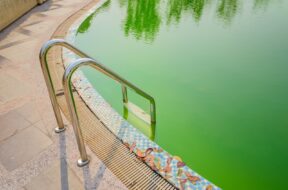
Want to learn more about algaecide? Read on to find out when to add algaecide to your pool maintenance routine and other helpful tips.
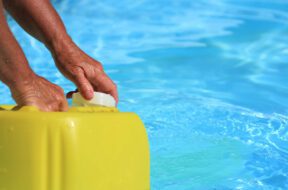
In this quick guide, we’ll answer the question “can you over shock a pool” and unveil the factors to consider when shocking a pool.
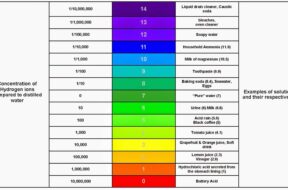
Maintaining both pH and total alkalinity in your swimming pool is important for keeping your pool properly sanitized and non-corrosive. Total alkalinity is to pH what cyanuric acid is to free chlorine. Total alkalinity stabilizes pH levels. The ideal pool pH level is 7.4 to 7.6. The ideal total alkalinity level is 80 to 120 ppm.
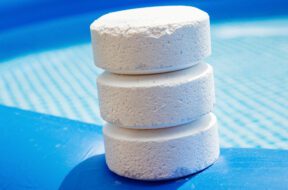
The Association of Pool and Spa Professionals recommends free chlorine levels for both swimming pools and hot tubs be kept between 2.0 and 4.0 ppm. However, the Center for Disease Control recommends free chlorine stay above 1 ppm in pools and 3 ppm in hot tubs.